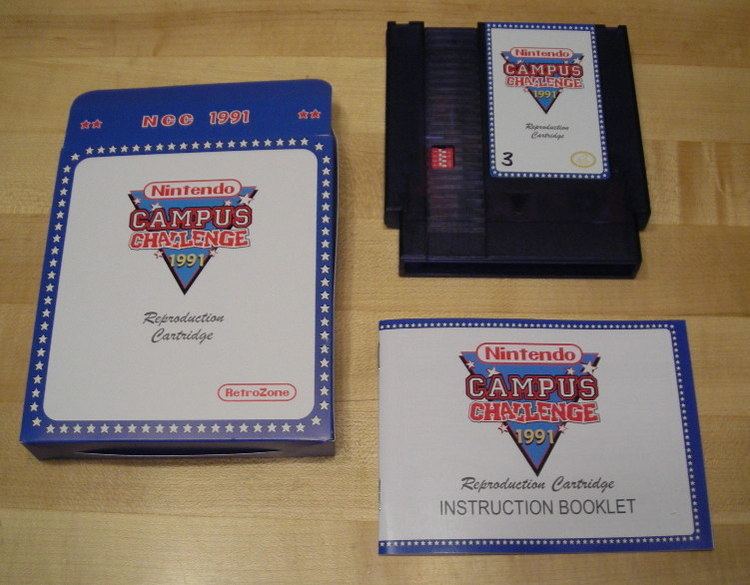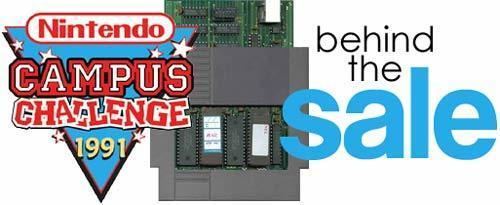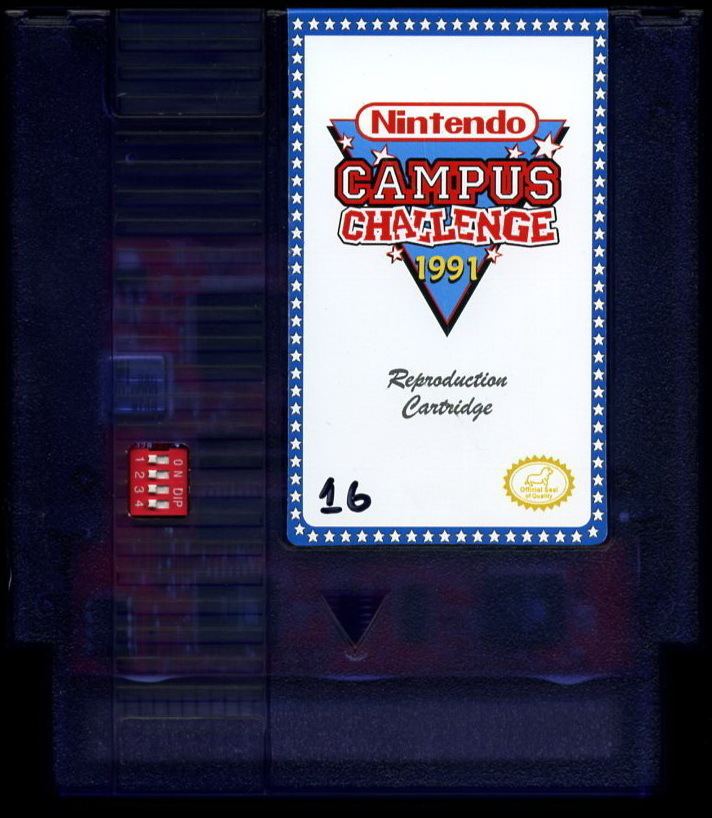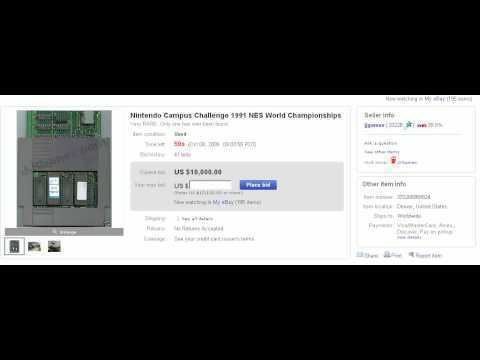 | ||
1991 nintendo campus challenge 16 208 000 obsolete
Nintendo Campus Challenge was a video game competition sponsored by Nintendo and held at nearly 60 college campuses and other events throughout the United States, including a Canadian Tour. There were two Campus Challenge events, one in 1991 and another in 1992.
Contents
- 1991 nintendo campus challenge 16 208 000 obsolete
- Nintendo campus challenge 1991 history of gaming
- 1991 games
- 1991 cartridge
- 1991 event structure
- 1992 games
- 1992 cartridge
- 1992 event structure
- References

Nintendo campus challenge 1991 history of gaming
1991 games

Like Nintendo World Championships, the official event gave each player 6 minutes and 21 seconds to play in the contest, but there are three different minigames. The first minigame of the competition is Super Mario Bros. 3, where players must collect 25 coins. The next minigame is a version of Pin*Bot, where players must get 100,000 points. The final minigame is Dr. Mario, which lasts until the time expires. Once time expires, a player's score is totaled using the following formula:
The following advertisement was printed in Game Players Strategy Guide to Nintendo Games Vol. 4, issue #5:

"Ok, you should really be studying for that calculus test next week. And there's a paper due in English Lit. But who cares? The Nintendo Camps Challenge is coming! Nintendo of America is following up its hugely successful Nintendo World Champions with its first Nintendo Campus Challenge. During the next year, competitions will be held at 50 universities and popular spring break gatherings throughout the U.S. One lucky student will become the 'college valedictorian of videogames.' Contestants will play a special combination of three Nintendo games - Dr. Mario, Rad Racer, and Super Mario Bros. 3. There are categories for both men and women, and all finalists receive round-trip airfare to the January 1992 championship. Prizes include new cars and cash scholarships. Meanwhile, don't let those grades slide too badly."
Rad Racer was not used in the final version of the competition cartridge, as it had previously appeared on the Nintendo World Championships cartridge and that both games used a different mapper chip than what the 1991 Nintendo Campus Challenge uses.
1991 cartridge

There is only one known original copy of the 1991 Campus Challenge cartridge known to exist. The game was found by a video game collector, Rob Walters, at a garage sale in New York in 2006. The game sold for $14,000 in July 2009 to collector JJ Hendricks. After 3 months, Hendricks resold the game on eBay for $20,100.
1991 event structure
The Nintendo Campus Challenge 1991 was held at 58 college campuses and spring break locations. The event consisted of three stages. The main stage had the competition on 12 different game stations. The second stage was Nintendo Entertainment System systems with various games while the third stage had Game Boy systems. Attendees at the events could play as many times as they wanted and the highest score at the end of the day was announced the winner.
The winner from each location was flown to Disney World in Orlando, Florida over New Year's weekend in January 1992. All the competitors played in the first round followed by a second round with the six highest scoring players only. The final round was a head-to-head match between Steven Lucas and Matt Sekelsky. Steven Lucas won with a score of 2,394,130.
1992 games
The SNES Campus Challenge cart has an unusual shape, with the PCB board parallel to the SNES. The cart has four ROM chips, presumably three for each game plus the additional one to link them all together. It also has the DSP-1 chip, which is used in Pilotwings. There is a set of eight switches, which were likely used to change the settings in the game, although they seemed to have no effect when changed. A phone jack is present, likely to relay the scores to a Nintendo server to determine the grand prize winner.
The rules are the same as the 1991 version, except with three SNES minigames. The first minigame of the competition is Super Mario World, where players must collect 50 coins (very similar to Nintendo World Championships' first minigame, Super Mario Bros.). The second game is a version of F-Zero, where players must complete two laps. The final minigame is Pilotwings, where players must land on two targets successfully. Once time expires, a player's score is totaled using the following formula:
1992 cartridge
There are reportedly three cartridges in existence, but only two known are known. One was found at the same New York City garage sale by Rob Walters as the 1991 cartridge. The cartridge is owned by a video game collector named Rick Bruns. The second one was found in an attic of a former employee of a company who did projects for Nintendo. Nintendo sent the cartridge to the company along with some systems and other games.
1992 event structure
The 1992 "Nintendo Campus Challenge" competition was held at 35 college campuses throughout the US, including Central Michigan University, Arizona State University, and Texas A&M University. The winner at each location won a Super NES Super Set with two controllers and a Super Mario World game cartridge, along with individual copies of F-Zero, and Pilotwings. Consolation prizes of $100, $75, and $50 were awarded to second, third, and fourth place contestants. The winner of the whole US competition won $10,000. In addition, all the winners were put into a draw to win prizes of $5,000. Along with the competition cartridge, Nintendo sent previews for new games, including Contra III: The Alien Wars, Rival Turf, The Legend of Zelda: A Link to the Past, The Addams Family, and Super Scope 6.
Similar competitions were held in Europe and Japan in 1992. The winner of the US competition, Jeff Hanson, won against the winner of the Japanese competition, Yuichi Suyama, and became the World Champion at the 1993 Consumer Electronics Show.
